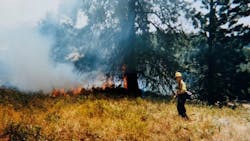Lockheed Martin Applies AI to Fighting Forest Fires
Artificial intelligence (AI) is enhancing many daily lives, but it may also help save lives, especially where massive forest fires are concerned. Wildfires are growing in recent years, due to such factors as rising global temperatures and drying forest lands. Large-area forest fires are causing losses of lives and entire communities, with devastating property damage.
Lockheed Martin is applying AI software to provide first responders and firefighters with powerful data analysis of raging forest fires to better understand their future directions and trends. By processing sensor data about forest fires, AI helps to generate the current state of a forest fire in minutes rather than hours.
The AI analysis tools compare sensor data with geographical information to calculate the best ways to suppress a wildfire. By combining AI and machine-learning (ML) technologies, data from space (satellite), air, and ground sensors can be analyzed and quickly communicated to firefighting teams through 5G cellular wireless communications networks.
For example, lightning strikes are often the source of wildfires; AI/ML tools process weather data to project regions of potential danger according to weather patterns. With available 5G services, including satellite communications (satcom) links, insights into forest-fire trends can be provided to firefighters and first responders even in remote areas. Lockheed Martin employs its joint all-domain command and control (JADC2) solutions with AL and ML to assist first responders in making rapid and intelligent decisions in battling forest fires.
Jim Taiclet, Lockheed Martin chairman, president, and CEO, said, “We have all the tools to address one of the fastest growing climate issues that we face: wildfires. Wildland fires have two detrimental effects to climate: they take out trees that would otherwise absorb carbon dioxide and pollute the air from resulting smoke. The mission here is how can we help predict, detect, and suppress wildfires much better than we ever could before with what we have today?”
About the Author
Jack Browne
Technical Contributor
Jack Browne, Technical Contributor, has worked in technical publishing for over 30 years. He managed the content and production of three technical journals while at the American Institute of Physics, including Medical Physics and the Journal of Vacuum Science & Technology. He has been a Publisher and Editor for Penton Media, started the firm’s Wireless Symposium & Exhibition trade show in 1993, and currently serves as Technical Contributor for that company's Microwaves & RF magazine. Browne, who holds a BS in Mathematics from City College of New York and BA degrees in English and Philosophy from Fordham University, is a member of the IEEE.
